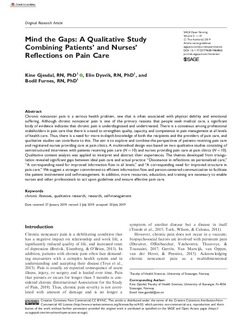| dc.contributor.author | Gjesdal, Kine | |
| dc.contributor.author | Dysvik, Elin | |
| dc.contributor.author | Furnes, Bodil | |
| dc.date.accessioned | 2020-01-28T10:15:19Z | |
| dc.date.available | 2020-01-28T10:15:19Z | |
| dc.date.created | 2019-09-05T09:46:12Z | |
| dc.date.issued | 2019-08 | |
| dc.identifier.citation | Gjesdal, K., Dysvik, E., Furnes, B., (2019) Mind the Gaps: A Qualitative Study Combining Patients’ and Nurses’ Reflections on Pain Care. Sage Open Nursing, 5 . | nb_NO |
| dc.identifier.issn | 2377-9608 | |
| dc.identifier.uri | http://hdl.handle.net/11250/2638285 | |
| dc.description.abstract | Chronic noncancer pain is a serious health problem, one that is often associated with physical debility and emotional suffering. Although chronic noncancer pain is one of the primary reasons that people seek medical care, a significant body of evidence indicates that chronic pain is underdiagnosed and undertreated. There is a consensus among professional stakeholders in pain care that there is a need to strengthen quality, capacity, and competence in pain management at all levels of health care. Thus, there is a need for more in-depth knowledge of both the recipients and the providers of pain care, and qualitative studies can contribute to this. The aim is to explore and combine the perspectives of patients receiving pain care and registered nurses providing care at pain clinics. A multimethod design was based on two qualitative studies consisting of semistructured interviews with patients receiving pain care (N = 10) and nurses providing pain care at pain clinics (N = 10). Qualitative content analysis was applied to interpret and abstract their experiences. The themes developed from triangulation revealed significant gaps between ideal pain care and actual practice: “Dissonance in reflections on personalized care,” “A corresponding need for improved information flow in all levels,” and “A corresponding need for improved structure in pain care.” We suggest a stronger commitment to efficient information flow and person-centered communication to facilitate the patient involvement and self-management. In addition, more resources, education, and training are necessary to enable nurses and other professionals to act upon guidelines and ensure effective pain care. | nb_NO |
| dc.language.iso | eng | nb_NO |
| dc.publisher | SAGE Publishing | nb_NO |
| dc.rights | Navngivelse-Ikkekommersiell 4.0 Internasjonal | * |
| dc.rights.uri | http://creativecommons.org/licenses/by-nc/4.0/deed.no | * |
| dc.subject | smerte | nb_NO |
| dc.subject | kronisk smerte | nb_NO |
| dc.subject | kronisk sykdom | nb_NO |
| dc.subject | self-management | nb_NO |
| dc.subject | chronic illness | nb_NO |
| dc.title | Mind the Gaps: A Qualitative Study Combining Patients’ and Nurses’ Reflections on Pain Care | nb_NO |
| dc.type | Journal article | nb_NO |
| dc.type | Peer reviewed | nb_NO |
| dc.description.version | publishedVersion | nb_NO |
| dc.rights.holder | © The Author(s) 2019 | nb_NO |
| dc.subject.nsi | VDP::Medical disciplines: 700 | nb_NO |
| dc.source.pagenumber | 10 | nb_NO |
| dc.source.volume | 5 | nb_NO |
| dc.source.journal | Sage Open Nursing | nb_NO |
| dc.identifier.doi | 10.1177/2377960819868865 | |
| dc.identifier.cristin | 1721754 | |
| dc.relation.project | Universitetet i Stavanger: IN-10519 | nb_NO |
| cristin.unitcode | 217,13,3,0 | |
| cristin.unitcode | 217,13,0,0 | |
| cristin.unitname | Avdeling for omsorg og etikk | |
| cristin.unitname | Det helsevitenskapelige fakultet | |
| cristin.ispublished | true | |
| cristin.qualitycode | 1 | |

